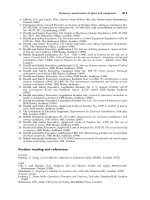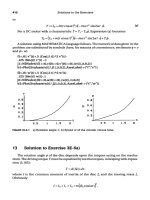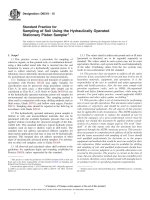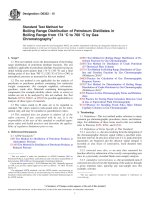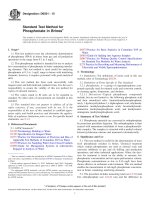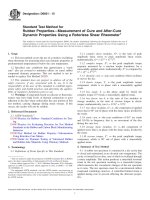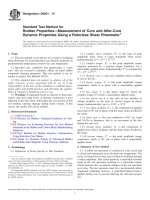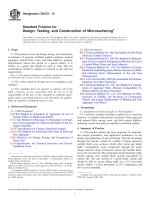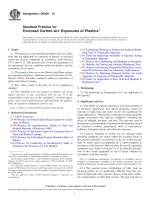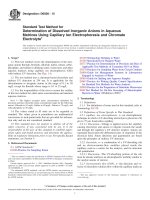Astm E 1159 - 15.Pdf
Bạn đang xem bản rút gọn của tài liệu. Xem và tải ngay bản đầy đủ của tài liệu tại đây (79.04 KB, 3 trang )
Designation: E1159 − 15
Standard Specification for
Thermocouple Materials, Platinum-Rhodium Alloys, and
Platinum1
This standard is issued under the fixed designation E1159; the number immediately following the designation indicates the year of
original adoption or, in the case of revision, the year of last revision. A number in parentheses indicates the year of last reapproval. A
superscript epsilon (´) indicates an editorial change since the last revision or reapproval.
E230 Specification and Temperature-Electromotive Force
(EMF) Tables for Standardized Thermocouples
E344 Terminology Relating to Thermometry and Hydrometry
1. Scope
1.1 This specification covers non-insulated platinumrhodium alloys (weight percent composition), and platinum
thermoelements that meet the requirement of Specification
E230 and NIST Monograph 175.2
3. Terminology
1.2 This specification does not cover platinum and
platinum-rhodium materials, that require a higher purity than
specified in 5.1, such as used for temperature coefficient of
resistance (TCR) measurements or standards type calibration.
For requirements of this superior quality, it is suggested that
suppliers of precious metals be contacted.
1.3 This standard does not purport to address all of the
safety concerns, if any, associated with its use. It is the
responsibility of the user of this standard to establish appropriate safety and health practices and determine the applicability of regulatory limitations prior to use.
3.1 Definitions— The definitions given in Terminology
E344 apply to terms used in this specification.
3.2 Definitions of Terms Specific to This Standard:
3.2.1 thermocouple type, n—a nominal thermoelectric class
of thermoelement materials that, used as a pair, have a
standardized relationship and tolerance between relative Seebeck EMF and temperature, physical characteristics, and an
assigned type letter designator and color code.
3.2.1.1 Discussion—Letter designators and color codes are
defined in the United States by ANSI/ASTM E230. Descriptions of letter designators and color codes may also be found in
ASTM MNL-12.4
2. Referenced Documents
2.1 The following documents of the issue in force on the
date of material purchase form a part of this specification to the
extent referenced herein.
4. Ordering Information
4.1 Orders for material under this specification shall include
the following:
4.1.1 ASTM designation and date of issue,
4.1.2 Thermocouple type (3.2.1),
4.1.3 Thermoelement diameter and tolerance (5.5),
4.1.4 Annealing requirements (5.4),
4.1.5 Quantity required (5.6, 5.7),
4.1.6 Specify standard or special tolerance on the initial
value of EMF vs. temperature,
4.1.7 Calibration requirement (5.8),
4.1.8 Chemical analysis (7.2.1),
4.1.9 Certified test results (7.2.2), and
4.1.10 Statement of compliance (7.2.3).
3
2.2 ASTM Standards:
B561 Specification for Refined Platinum
B616 Specification for Refined Rhodium
E207 Test Method for Thermal EMF Test of Single Thermoelement Materials by Comparison with a Reference Thermoelement of Similar EMF-Temperature Properties
E220 Test Method for Calibration of Thermocouples By
Comparison Techniques
1
This specification is under the jurisdiction of ASTM Committee E20 on
Temperature Measurement and is the direct responsibility of Subcommittee E20.04
on Thermocouples.
Current edition approved Dec. 1, 2015. Published December 2015. Originally
approved in 1987. Last previous edition approved in 2009 as E1159 – 98 (2009).
DOI: 10.1520/E1159-15.
2
“Temperature-Electromotive Force Reference Functions and Tables for the
Letter-Designated Thermocouple Types Based on the ITS-90,” NIST Monograph
175 and Supplement 1. Available from NIST, U.S. Dept. of Commerce,
Gaithersburg, MD 20899.
3
For referenced ASTM standards, visit the ASTM website, www.astm.org, or
contact ASTM Customer Service at For Annual Book of ASTM
Standards volume information, refer to the standard’s Document Summary page on
the ASTM website.
5. Requirements
5.1 Purity—The purity of platinum for use in the negative
thermoelement of Type R and Type S thermocouples shall be
Grade 99.99, as specified in Specification B561.
4
Manual on the Use of Thermocouples in Temperature Measurement, ASTM
MNL-12, Fourth Edition, ASTM, April 1993. (Revision of STP 470B).
Copyright © ASTM International, 100 Barr Harbor Drive, PO Box C700, West Conshohocken, PA 19428-2959. United States
1
E1159 − 15
ment of the ordering information given in Section 4 and listed
in Table 1 of Specification E230. Roll length shall be limited to
610 m (2000 feet) for wire lot calibration.
5.8.1 Sample Length— The lengths of thermoelements to be
tested shall be approximately 1 m (3 ft.) taken from each end
of the spool or coil.
5.8.2 Calibration Temperature—Unless otherwise specified
with the order, the sample thermocouple shall be calibrated at
a single temperature of 1200 6 100°C.
5.8.3 Alternative Calibration Method —A thermoelement
calibration versus a suitable secondary reference
thermoelement, may be specified as an option in the ordering
information. A description of this method can be found in Test
Method E207.
5.8.3.1 Unless otherwise specified with the order, the thermoelement material shall be such that, when calibrated at a
single temperature of 1200°C, a difference in the initial value
of EMF vs. temperature of no greater than 10 microvolts may
be present between the beginning and the end of the thermoelement lot when tested in accordance with Test Methods
E207 and E220.
5.8.3.2 The thermoelements shall be such that, when
matched as a thermocouple, the EMF output shall meet the
tolerance on the initial value of EMF vs. temperature as
specified in 4.1.6.
5.1.1 The purity of platinum, before alloying, for use in the
positive thermoelement of Type R, S, and both thermoelements
of Type B shall be Grade 99.99, as specified in Specification
B561.
5.1.2 The purity of rhodium, before alloying, for use in the
positive thermoelement of Type R, S, and both thermoelements
of Type B shall be Grade 99.95, as specified in Specification
B616.
5.1.3 In the case of a conflict between the material composition and the EMF output of the thermoelement, the calibration requirement of Specification E230 shall govern.
5.2 Physical Condition—All material to be supplied shall
consist of continuous lengths which shall be free of kinks and
shall be round and smooth. Any pits or dents that exceed 10 %
of the diameter shall be cause for rejection of the material.
5.3 Cleanliness— After material has been processed to its
final diameter and prior to subsequent anneal, it shall be
cleaned to remove all dirt, lubricant, fingerprints, or other
foreign residue. This state of cleanliness shall be maintained
throughout testing and throughout any further work and
shipment.
5.3.1 Prior to any testing, cleanliness of the material shall be
verified by wiping with a cotton swab. Any indication of oil,
dirt, or discoloration after wiping shall be cause for rejection of
the spool from which the sample was taken.
6. Rejection
5.4 Annealing—Prior to any testing or shipment, material
equal to or greater than 0.25 mm (0.010 in.) in diameter shall
be annealed by heating to at least 1000°C in air for a minimum
of 1 minute. Material smaller than 0.25 mm (0.010 in.) in
diameter shall be supplied in the hard drawn temper unless
otherwise specified in the ordering information.
6.1 Purchaser Test Results—The purchaser may perform
tests and inspection to verify that the delivered material meets
the contract requirements. Failure to pass the purchaser’s
inspection and test may be cause for rejection.
6.2 The suppliers test results and inspection report may also
be used as a basis of acceptance or rejection. Failure of
suppliers to meet the contract requirements may be cause for
rejection.
5.5 Diameter—Sizes may range from 0.05 mm (0.002 in.) to
1.5 mm (0.060 in.). Required size shall be stated in the ordering
information. Supplier’s practice on tolerance shall apply unless
otherwise stated in the ordering data (4.1.3). Any localized
necking or bulging of the conductor beyond tolerance limits
shall be cause for rejection.
7. Identification and Certification
7.1 Material Identification—The supplier shall maintain
sufficient records to ensure identification and traceability of all
raw materials, verifying that all material used is in compliance
with 5.1.
NOTE 1—Tolerances may vary from supplier to supplier.
5.6 Length—Quantity of material supplied shall meet the
requirements of the ordering data. Only a single continuous
length may be placed on any one spool. Splicing of wires is
prohibited.
7.2 Material Certification—When required, the supplier
shall furnish with the shipment the following certification and
statements:
7.2.1 Certified chemical analysis of the material from which
the material was made,
7.2.2 Certified results of tests performed on the material
supplied in accordance with this specification and the ordering
documents, and
7.2.3 A statement of compliance that the material meets
requested requirements of this specification.
5.7 Weight—Purchaser may alternatively request material
by weight (grams or troy ounces) instead of length. All other
requirements of this section shall be met. If weight is specified,
a statement of weight/unit length accurate to within 1 % shall
be supplied for each item.
5.8 Thermocouple Calibration—Sample thermocouples
made from the specified thermoelements shall be calibrated
according to the procedures set forth in Test Method E220. The
thermocouple shall conform to the appropriate table in Specification E230. They shall meet the tolerance on the initial value
of EMF vs. temperature as specified in the tolerance require-
8. Keywords
8.1 platinum; rhodium; thermoelement; thermocouple materials; type B; type R; type S
2
E1159 − 15
ASTM International takes no position respecting the validity of any patent rights asserted in connection with any item mentioned
in this standard. Users of this standard are expressly advised that determination of the validity of any such patent rights, and the risk
of infringement of such rights, are entirely their own responsibility.
This standard is subject to revision at any time by the responsible technical committee and must be reviewed every five years and
if not revised, either reapproved or withdrawn. Your comments are invited either for revision of this standard or for additional standards
and should be addressed to ASTM International Headquarters. Your comments will receive careful consideration at a meeting of the
responsible technical committee, which you may attend. If you feel that your comments have not received a fair hearing you should
make your views known to the ASTM Committee on Standards, at the address shown below.
This standard is copyrighted by ASTM International, 100 Barr Harbor Drive, PO Box C700, West Conshohocken, PA 19428-2959,
United States. Individual reprints (single or multiple copies) of this standard may be obtained by contacting ASTM at the above
address or at 610-832-9585 (phone), 610-832-9555 (fax), or (e-mail); or through the ASTM website
(www.astm.org). Permission rights to photocopy the standard may also be secured from the Copyright Clearance Center, 222
Rosewood Drive, Danvers, MA 01923, Tel: (978) 646-2600; />
3
